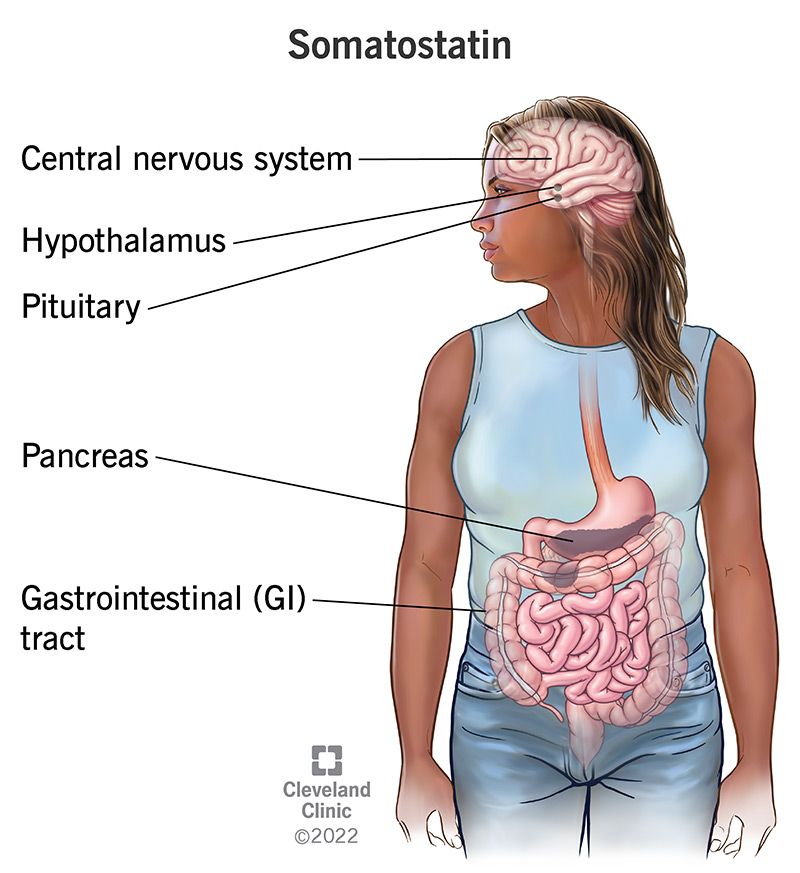Somatostatin is an important hormone that works to inhibit the release of other hormones. It also regulates the activity of your gastrointestinal tract and prevents the rapid reproduction of cells.
Advertisement
Cleveland Clinic is a non-profit academic medical center. Advertising on our site helps support our mission. We do not endorse non-Cleveland Clinic products or services. Policy

Somatostatin is a hormone that regulates a variety of bodily functions by hindering the release of other hormones, the activity of your gastrointestinal tract and the rapid reproduction of cells.
Advertisement
Cleveland Clinic is a non-profit academic medical center. Advertising on our site helps support our mission. We do not endorse non-Cleveland Clinic products or services. Policy
Hormones are chemicals that coordinate different functions in your body by carrying messages through your blood to your organs, skin, muscles and other tissues. These signals tell your body what to do — or stop doing — and when to do it.
Many different tissues produce somatostatin, including tissues in your:
Other names for somatostatin include:
Advertisement
Healthcare providers use a synthetic form of somatostatin to treat certain health conditions, including:
The primary function of somatostatin is to prevent the production of other hormones in your endocrine system and certain secretions in your exocrine system. Your endocrine system consists of glands that release hormones directly into your bloodstream. Endocrine glands include your thyroid, pituitary gland and adrenal glands. Your exocrine system consists of glands that release substances through a duct. Exocrine glands include salivary glands, sweat glands and glands within the gastrointestinal tract.
Basically, somatostatin works to turn off the faucet and the flow of certain hormones and secretions when your body doesn’t need them (temporarily) anymore.
Somatostatin also stops the unnatural rapid reproduction of cells such as those that may form tumors. In addition, somatostatin acts as a neurotransmitter in your central nervous system. A neurotransmitter is a signaling molecule that a neuron releases to affect another cell.
Somatostatin affects several different areas of your body:
Scientists don’t yet fully understand how our bodies regulate the release of somatostatin and what causes tissues to release it. So far, they do know that several different cells and substances, such as proteins, play a role in causing somatostatin release.
One study on somatostatin revealed that glucose (sugar), the main form of energy your body uses, not only regulates somatostatin release but also plays a role in the production of somatostatin. The scientists behind the study detected insulin-stimulated somatostatin (insulin-inhibiting somatostatin) release only when there were low blood glucose levels and glucagon-stimulated somatostatin (glucagon-inhibiting somatostatin) when there were high blood glucose levels.
Advertisement
In other words, since insulin decreases blood glucose levels, your body releases somatostatin to stop insulin release when you have low blood glucose to prevent your levels from dropping further.
The main condition related to somatostatin issues is a very rare endocrine tumor called somatostatinoma. The tumor originates in your pancreas or gastrointestinal tract and produces excess amounts of somatostatin.
Somatostatinoma can occur randomly or in association with certain genetic syndromes, including:
Excess somatostatin results in an extreme reduction of the release of many other endocrine hormones. Symptoms can be similar to symptoms of many other conditions, so somatostatinoma can be difficult to diagnose.
Advertisement
There are very few reports of someone having lower-than-normal levels of somatostatin.
Since somatostatin issues are rare, healthcare providers typically only use a blood test called somatostatin-like-immunoreactivity (SLI) to check somatostatin levels to diagnose somatostatinoma, a very rare tumor that produces excess somatostatin.
Issues with somatostatin levels are rare, so you likely won’t need to have your somatostatin levels checked. However, if you have a first-degree relative (parent or sibling) that has been diagnosed with multiple endocrine neoplasia type 1, neurofibromatosis type 1 or Von Hippel-Lindau disease, it’s important to tell your healthcare provider. These inherited (passed through the family) conditions can put you at risk of developing somatostatinoma.
Somatostatin is an important hormone that affects many aspects of your body. Luckily, somatostatin usually works as it should, as issues with somatostatin and somatostatinomas are rare. If a member of your family has been diagnosed with an inherited condition that puts them at risk for developing a somatostatinoma, let your healthcare provider know. They can run some tests to see if you could also have the condition.
Advertisement
Hormonal conditions can be tricky to find and complicated to treat. The experts in endocrinology at Cleveland Clinic are here to provide the best care.

Last reviewed on 04/25/2022.
Learn more about the Health Library and our editorial process.